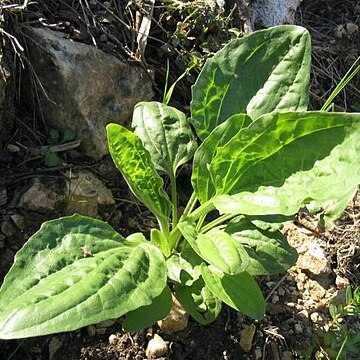Herbs, or rarely small shrubs or arborescent, annual, biennial, or perennial, acaulescent or infrequently stemmed, with a taproot, caudex, or only numerous fibrous roots. Leaves simple; petiole vaginate at base; leaf blade ovate, elliptic, oblong, lanceolate, linear, or subulate, margin entire, repand, erose, or toothed, rarely pinnately or palmately cleft. Inflorescences arising from rosette or leaf axil of stem, spikes, narrowly cylindric, capitate, or rarely 1-flowered. Corolla salverform or tubular, persistent; tube cylindric or constricted at throat, as long as or slightly longer than calyx; limb 4-parted. Stamens (1 or 2 or)4; anthers ovoid, suborbicular, ellipsoid, or oblong. Ovary 2-loculed or rarely 1-locular but sometimes with an apical third compartment, placentation axile or rarely basal, with 1 to numerous ovules per locule. Fruit a pyxis, rarely an indehiscent capsule or nutlet, with 1 to numerous seeds. Seeds peltately inserted; testa mucilaginous when wet; embryo straight; cotyledons parallel or vertical to ventral (hilum) side.
Annual or perennial herbs. Stems usually simple and very short, forming a caudex (rootstock) at or below ground level, sometimes elongated and branched, often with long hairs, occasionally woody and forming small subshrubs. Primary root persistent, or short-lived with subsequent adventitious root system. Lvs usually in basal rosettes, sometimes cauline, opposite or alternate. Fls in heads or cylindric spikes, rarely solitary, 4-merous, usually ☿ and protogynous, sometimes unisexual; sepals similar to bracts, equal or not, free or connate at base. Corolla scarious or membranous; tube narrow, persisting at fr. apex; lobes usually patent or deflexed. Stamens epipetalous, usually exserted but included in cleistogamous fls. Ovary 2-locular, but sometimes appearing 4-locular by placental outgrowths; placentation axile. Ovules 1-6-(8) per loculus; style filiform. Capsule circumscissile, enclosed in persistent calyx. Seeds 1-many, ± mucilaginous when wet.
Annual or perennial herbs. Stems usually simple, arising from a rootstock at or below ground level, sometimes branched and plant subshrubby. Leaves usually all basal (rosette), crowded, sometimes cauline, mostly with 3–9 longitudinal veins. Inflorescence spicate, cylindrical to globose (rarely flowers solitary), bracteate, bracts usually membranous. Flowers bisexual, 4-merous. Sepals resembling bracts, with a prominent keel, persistent in fruit. Petals united below into a narrow tube, persistent on top of capsule. Stamens 4, adnate to corolla tube, long-exserted, the anthers usually much exserted on thread-like filaments, with a terminal appendage. Ovary superior, usually 2-locular, sometimes becoming 3-or 4-locular by placental outgrowths; ovules 1–6 (–8) per locule; style filiform, stigma papillose. Fruit a circumscissile capsule with lower portion persistent. Seeds 1–16, mucilaginous when wet.
Annual or perennial, terrestrial, caulescent or mostly acaulescent herbs or suffruticose herbs. Leaves usually all radical but sometimes, in the species with developed stems, cauline. Flowers nearly always hermaphrodite, 4-merous, in heads or cylindrical spikes. Stamens inserted in the corolla-tube. Ovary 2-4-locular; ovules 1-many in each locule. Capsule circumscissile. Seeds 1-many in each locule, usually ± boat-shaped with ventral hilum; albumen fleshy; embryo straight or curved; radicle inferior.
Fls mostly perfect in heads or cylindrical spikes, sts reduced to a single fl. Stamens inserted on corolla-tube, ovules 2 to many. Capsule circumscissile, 1-to many-seeded. Terrestrial herbs; bases of petioles including tufts of long woolly or silky hairs in many spp. Mostly protogynous and wind-pollinated. About 200 spp. mostly in temperate regions. N.Z. spp. endemic except 2; several widespread European spp. are thoroughly naturalized.
Fls sessile or subsessile in the axils of bracts, aggregated into spikes or heads; sep 4, the 2 next the bract often slightly different from the 2 next the axis (sometimes ± connate); cor long-persistent, its tube investing the summit of the fr; capsule circumscissile at or below the middle; ours annual or perennial herbs, most spp. acaulescent.200+, cosmop.
Corolla 4-lobed, somewhat scarious; tube campanulate-tubular or urceolate; lobes lanceolate or ovate, shorter than the tube, usually with membranous margins or deflexed.
Seeds 1-many in each locule, usually more or less boat-shaped with ventral hilum, mucilaginous when wet; albumen fleshy; embryo straight or curved; radicle inferior.
Ovary globose or nearly so, bilocular, ovules 1-many in each locule; style usually much exserted and villous, more rarely included; stigma simple.
Leaves usually in radical rosettes or opposite or alternate on branched stems, various in shape, usually entire.
Inflorescence a pedunculate, cylindrical spike or head, with inconspicuous flowers, each subtended by a bract.
Stamens 4, inserted in the corolla tube, alternating with the corolla lobes, exserted; filaments slender.
Herbs with usually radical leaves and long-pedunculate spikes of small flowers
Annual or perennial, terrestrial, caulescent or mostly acaulescent herbs.
Flowers almost always hermaphrodite, 4-merous.
Fruit a membranous capsule, circumscissile.
Calyx about as long as the corolla tube.
Fruit a circumscissile capsule.
Stamens usually 4
Anthers versatile
Disk rare.

